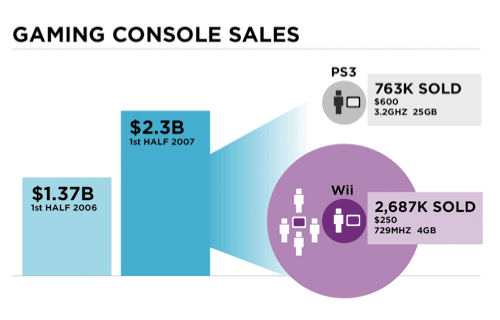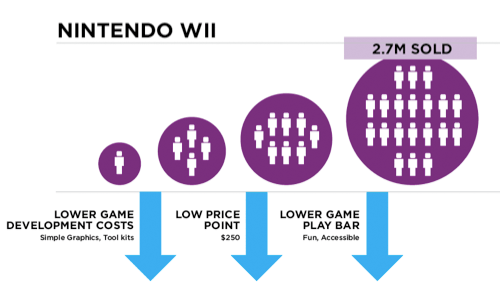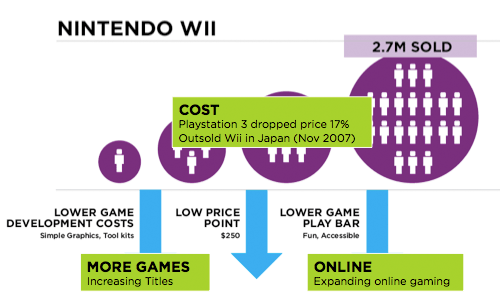When we teach our Influencing Strategy by Design course, Tom Chi and I ask our students to visualize the video game console market using data from 2007 and early 2008. At that time:
- In 2008 the video game industry had sales of $21.33 billion. Hardware was $7.81 billion and software was $10.96 billion. (source)
- This was up 19% over 2007 (which saw a 43% increase over 2006). (source)
- In 2007 & 2008, the Nintendo Wii sold a cumulative total of 16.4 million consoles. Microsoft's Xbox 360 sold 9.3 million consoles. Sony's Playstation 3 sold 6.1 million consoles. (source)
- In June of 2007, the Nintendo Wii outsold the PS3 6 to 1 in Japan. (source)
- In August of 2007, the Nintendo Wii's worldwide sales surpassed the life time Xbox 360 sales in less than a year. In so doing, the Wii became the fastest selling game console of all time. (source)
- When it had them in stock, Amazon sold 17 Nintendo Wii gaming systems a second. (source)
- In mobile game consoles, Nintendo sold 18.5 million Nintendo DS units and Sony sold PSP units 7.64 cumulatively in 2007 and 2008. (source)
In other words, Nintendo was on a roll and selling more video game consoles (home and mobile) than anyone. As the diagram below shows, the game console market was growing and the Wii was taking a very large piece of this increasing pie despite significantly lower technical prowess: 729mhz processor vs. 3.2ghz processor (PS3) and 4GB of memory vs. 25GB of memory (PS3).

In our course we asked students to explore ways to visualize why this was happening. Here's an example highlighting the impact of:
- Lower development costs: the Wii's simple graphics and tool kits made it easy for developers to create games fast. Since games sell consoles, having more good games up front helped the Wii a lot.
- A low price point: originally intended to cost $100, the Wii was ultimately priced at only $250. That was less than half the cost of a $600 PS3.
- A lower game play bar: the Wii's innovate motion controller let anyone easily learn and start playing. This opened up the Wii's potential audience to a large set of "non-gamers" interested in having fun with friends and family.

Each of these factors contributed to 2.7 million Wiis sold in the first half of 2007. But they also presented opportunities for competitors, new entrants, and Nintendo.

Microsoft and Sony focused on getting popular games on their consoles like Halo and Rock Band (which took a long time to reach the Wii). They both pursued aggressive price reductions. In fact, when the PS3 dropped its price by 17% in November of 2007, it actually outsold the Wii in Japan that month. Since then (in August 2009) Microsoft's Xbox dropped in price by $100 and Sony released a PS3 Slim version with a $100 reduction in price. These moves "forced" Nintendo to adjust the Wii's pricing as well. In September 2009 The Wii's cost dropped by $50.
Across the dozen times we taught the Influencing Strategy by Design course, many other market opportunities were proposed by our students in the video game market including:
- Selling accessories that enhance gaming consoles bundled with games that utilize them.
- Innovating in mobile gaming by lowering the game play bar on mobile consoles to bring in a new set of game players -essentially what Nintendo did with the Wii in the home console market.
- Enabling in-console marketing and sales of games. At the time, the average Wii owner only bought 3.7 games a year compared to 4.7 for the average Xbox 360 owner
Looking at the video game market today, we can see how these opportunities played out.
Bundling Accessories with Games
- In 2008, the three best selling video games (single SKU) were all bundled with console accessories: Wii Play w/ remote 5.28 million, Mario Kart Wii w/ wheel 5.00 million, Wii Fit w/ balance board 4.53 million (source)
- In just over a year, Nintendo sold more than 15 million units of its "Wii Fit" system (source)
- At the end of June 2009, Mario Kart Wii w/ wheel and Wii Fit w/ balance board were the top selling video games of the year. (source)
Price Cuts
- Nintendo’s price cut on the Wii in the US had a big impact on October 2009 sales, making the Wii the bestselling console in the country last month, after being outsold by the PlayStation 3 the previous month. (source)
- Yet, US consumers spent $380.74 million on video game hardware last month, down 23% from October 2008. (source)
- In fact, US video game sales fell 19% in October 2009 -the seventh month this year in which sales have fallen short of year ago figures. The industry is on track to generate full-year sales of $20 – $21 billion, which will put it below last year’s sales of $21.3 billion. (source)
- In October of 2009, Nintendo reported a 52% drop in profit for the first half of its fiscal year, which ends in March, as sales of its Wii console and DS gadgets cooled. It also predicted its annual profit would fall for the first time in six years. (source)
- Nintendo Wii sales stalled, dropping to 2.23 million units in the April-to-June quarter from 5.17 million a year earlier. (source)
- Global unit sales of Nintendo DS devices were down about 15% to 11.7 million in the six months ended September, but the DS has fared better than the PSP, whose unit sales dropped 38% in the same period. (source)
Mobile Gaming
- Growth for dedicated game machines like the DS and PSP has peaked and Apple products will drive the portable game market over the next five years. Revenue from iPhone and iPod Touch games is expected to rise from $46 million in 2008 to more than $2.8 billion in 2014. (source)
- The Apple devices can tap into thousands of video games available for download at its App Store. Some are free to play and most sell for under $10. New DS games start at about $20. (source)
- In a conference call about its financial results, a Nintendo representative claimed the DS and DSi were suffering, “due to harsher competition in the portable arena stemming directly from Apple devices" (source)
- Number of games available on Sony PSP portable gaming platform: 607 titles. Nintendo DS portable gaming platform: 3,680. iPhone OS: 21,178 titles (source)
- On average, users download 6.6 million apps per day from the Apple App Store (source)
- A year ago, Nintendo also introduced a new version of its DS handheld device that lets users download digital content, including music, photos, videos and games, via a Wi-Fi connection — a clear imitation of Apple’s App Store. (source)
Given these changes, it will be interesting to see what students taking the course in the future come up with next.